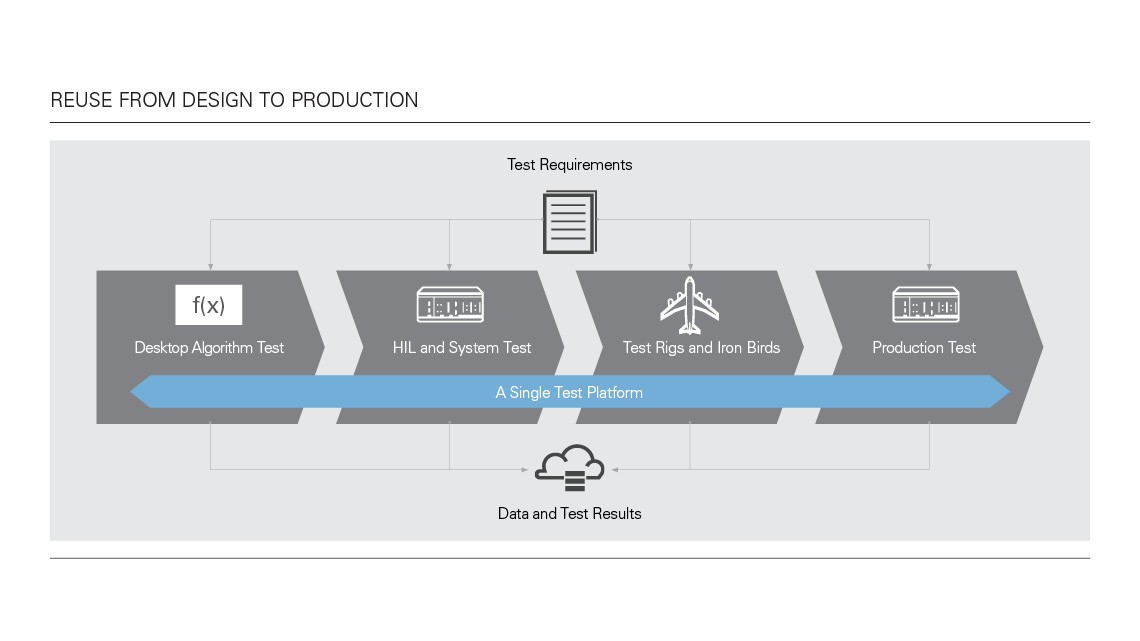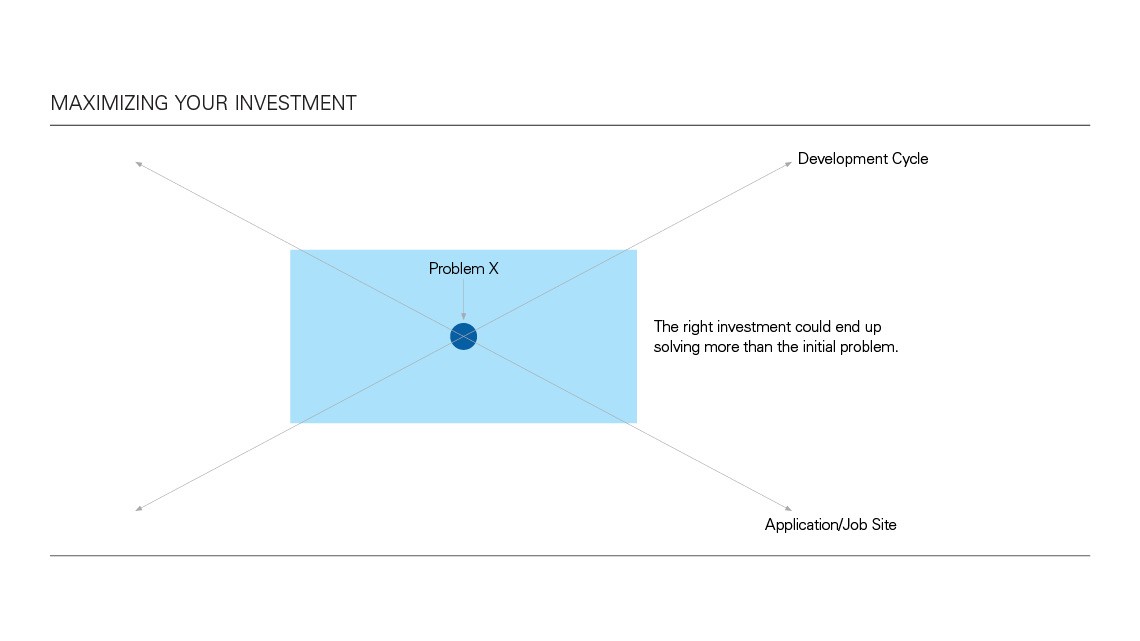Empowering Future-Proof Test Organizations Through Standardization
Overview
Aerospace and defense organizations find themselves in a continual juggling act of integrating cutting-edge technology while maintaining legacy testers, providing comprehensive test coverage, and, most importantly, meeting scheduling demands. Leaders in this field need a more standardized approach to test that can be used for legacy and new technology as well as a variety of systems and test groups. This approach offers a more sustainable solution that allows test engineers to innovate rather than spend time creating and maintaining internal tools. Read this document to explore the benefits of this approach and a solution that leading aerospace and defense organizations can implement for truly future-proof test.
Contents
- Reuse From Design to Production
- Standardizing Across the Development Cycle
- Standardizing Across Applications and Job Sites
- Empowering Standardization
Reuse From Design to Production
Test organizations in the aerospace and defense industry must continually balance their needs for test coverage, project schedule, and budget. To satisfy these competing demands, they customize their solutions to fully control timelines and technical risk, but this comes at a cost. They ultimately must choose between running over budget, paying overtime, committing more resources to a problem, or postponing needed test system upgrades to try to meet project deadlines.
The least attractive choice for these organizations is compromising on test coverage and living with the possibility that they missed something or released an inferior product. This constant tension has been the status quo of the aerospace and defense industry, and, though it’s not ideal, it has inspired remarkable successes. The industry’s positive track record begs the question, “If it’s not broken, why fix it?” But the industry should ask, “Is this approach sustainable?”
As customers demand new technology in modern aircraft, trends like electrification take deeper hold, and companies continue to see value in international talent that requires global development sites, aerospace and defense organizations need to determine whether the status quo is the right choice for a future of growth. The ability to modernize test and design cycle approaches with standardized test architectures, more emulation and simulation, and new and improved systems and data management tools is the difference between thriving with a sustainable competitive advantage and struggling to survive. Organizations can standardize test by using the same technology and tools across the development cycle and across applications and job sites.
Standardizing Across the Development Cycle
Though test engineers generally specialize in a particular phase of the development cycle, a successful test organization must consider the test process holistically. Test managers oversee budgets for different kinds of test and make sure that each stage efficiently leads to a released product. But if test groups rely on mostly in-house-created technology, each group must operate differently and approach its test designs based on its own preferences and needs. Purpose-built systems for different programs present the same problem: they were designed for one program without considering the holistic needs of the test organization. Without self-imposed, company-wide standards that are maintained and governed, organizations don’t have to check for consistency between groups. Test managers are familiar with these challenges and are succeeding despite them. However, with each success comes an accumulating risk of failure and misuse of time and money. These considerations contribute to the bane of every engineer’s existence: inefficiency.
Using a standardized approach to the entire test cycle, engineers can consistently compare data at each stage of the test journey and move test, especially simulation- and emulation-based test, earlier in the development cycle. They can reliably reference the data collected during the validation of a component when testing that component in a system. Additionally, engineers from various groups have a common language and approach that promotes sharing best practices and collaborating more effectively. A standard approach also allows test engineers to delve deeply into their areas of expertise without worrying about other groups because a consistent platform ensures that the output of one group is a compatible input for the next. Finally, test organizations can more fully realize their financial investment because they can reuse test systems from one group to the next. This outcome is also possible with a custom approach, but that requires an in-house governing body and is often unsustainable and inefficient. The solution is not more red tape.
Standardizing Across Applications and Job Sites
Project groups, especially in different programs, can devolve into isolated entities at aerospace and defense companies. Management structures, budget distribution, and historical practices can lead to disconnected endeavors. Large companies are particularly susceptible to this dilemma because different groups implement different projects at different sites, heightening the challenge of maintaining consistency. Though the status quo is a proven method of maintaining stability in this industry, organizations should consider standardization for this goal as well.
A consistent approach to test offers a way to shift talent wherever and whenever necessary. Engineers know how to use similar tools, so moving talent among projects and locations is easy. This flexibility also can increase employee engagement, decrease burnout, and reduce the risk of developing tribal knowledge that’s lost when an employee leaves the organization. Additionally, with a standardized approach to test, companies can provide clearer expectations to their customers. For example, a supplier may be responsible for more than one subsystem of an aircraft. A standardized test approach at the supplier means it delivers test racks based on the same approach to the airframer across subsystems, which reduces the integration challenge airframers face.
Empowering Standardization
The aerospace and defense industry must exert control over its technology to mitigate risk and meet certifications. Traditionally, safeguarding proprietary data has made purchasing from a vendor problematic. However, by investing in a platform-based approach featuring commercial off-the-shelf (COTS) technology, aerospace and defense corporations can meet their standardization goals without sacrificing knowledge of the underlying technology.
NI has a 40-year history of working with leading aerospace and defense companies and suppliers. Based on this experience, NI engineers have created a platform broad enough to span the needs of various industries but nimble enough to be tailored to specific application requirements. NI’s modular hardware paired with highly integrated software provides the technology these organizations need from validation to production test. They can easily adapt this platform as they adjust to changing test requirements or kick off a new project. Based on modular technologies like PXI and switch, load, and signal conditioning (SLSC), NI test systems offer full control to test engineers without the burden of intensive custom design. Additionally, a global network of industry-seasoned NI Partners is ready to provide integration and customization services to make sure these test systems meet organizations’ specific requirements.
Standardization maximizes an investment from project to project and test to test. This sustainable approach is the hallmark of truly future-proof aerospace and defense organizations.
An NI Partner is a business entity independent from NI and has no agency or joint-venture relationship and does not form part of any business associations with NI.
